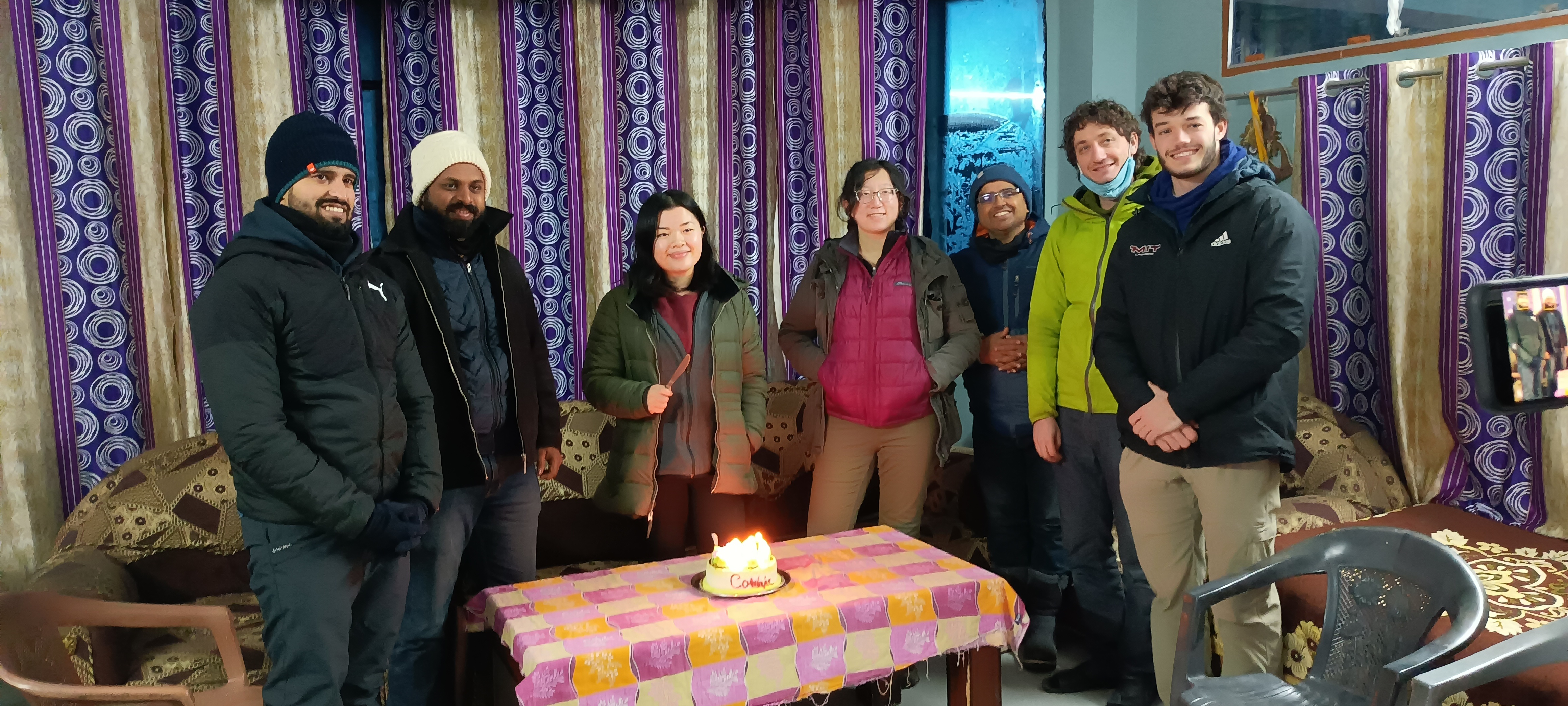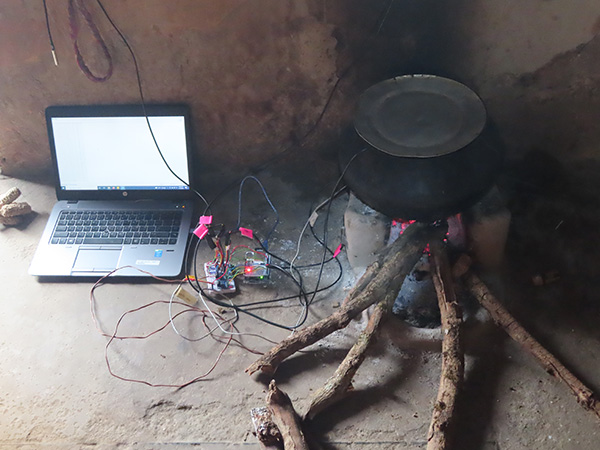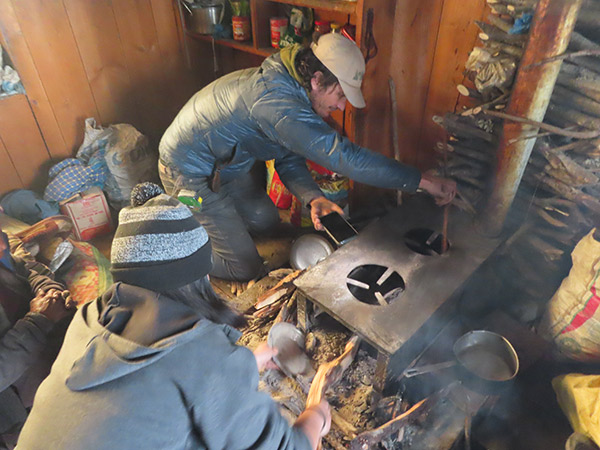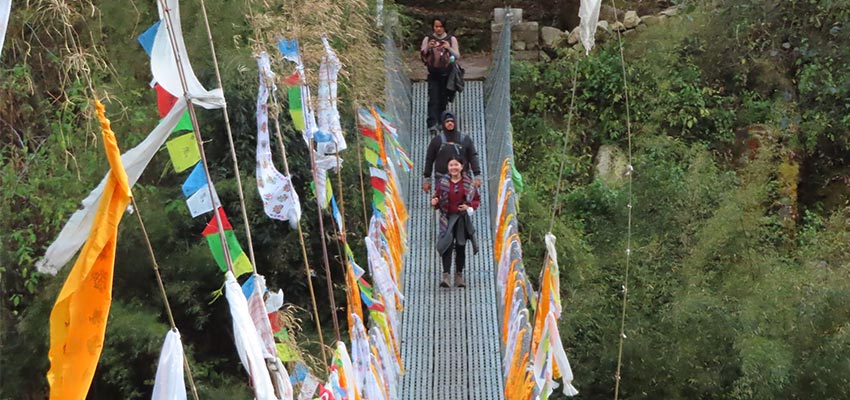
"In this time of isolation, this trip was a precious chance to connect with the communities that form the foundation of our research, as well as with students and researchers at other universities."
The project and the team
In January 2022, during MIT’s Independent Activities Period, a team from MIT D-Lab visited North India and Nepal to conduct field research regarding firewood cooking and heating stoves in the Himalayan region. The team consisted of Dan Sweeney, a D-Lab research scientist, Lisa Tang, a master’s student in mechanical engineering, and Connie Ly and Luke Chapman, two undergraduate sophomores in mechanical engineering. Working with partner universities in India and Nepal, we gathered information about households and stoves in order to develop solutions to improve stove performance and reduce household air pollution.
For all three of us students, it was our first time traveling internationally since the beginning of the COVID-19 pandemic. We were all excited for the opportunity to connect with the communities that we had been collaborating with, and even as we boarded the 14-hour flight from the United States to New Delhi, it was difficult to believe that the trip was really happening.
In India, we were joined by Dr. Pranava Chaudhari from University of Petroleum and Energy Studies (UPES) in Dehradun, and Akshansh Kataria and Rahul Kumar from Ecosense Appliances, a cookstove manufacturing company. We also worked with Emmanuel Kamatham, from the NGO Emmy’s Hands. In Nepal, we met with Dr. Binaya KC and Professor Shrestha Bim from Kathmandu University (KU), and were joined by students and researchers from KU on the field visits.
Knowledge gained
In each country, we visited two or three different towns and villages. The locations were all unique from one another in many ways - their degree of remoteness, their sources of income, the designs and materials of the stoves, the layout and construction of the houses. The altitude of the villages ranged from the foothills of the Himalaya at 1,000 meters up to snowy valleys at elevations of 4,000 meters.
At each location, we conducted surveys regarding stove design and construction, fuel gathering and fuel use, and cooking and heating practices. Our community partners helped bridge the language barrier we faced when communicating with local community members. We also carried sensors to monitor ambient indoor and outdoor temperatures, humidity, and the levels of various pollutants, including carbon monoxide and particulate matter. We installed them in kitchens to see how those values changed throughout the day and night with cookstove usage. We brought a small sensor system of thermocouples and temperature probes to test local stoves to assess their efficiency and other performance metrics.

While the numerical data we collected was important, so was the ability to experience firsthand the locations we were working in. We saw the wide variety of stove designs that households used, from clay and mud stoves at lower altitudes to sheet metal stoves in colder regions. We witnessed for ourselves the remoteness of some of the villages, and the difficulty of transporting supplies, construction materials, and fuels. Huddled around the heating stove at night for warmth with below-freezing temperatures outside, we gained a better understanding of the importance of these stoves in people’s lives.
Forming connections
Throughout the trip, the people we encountered were generous and hospitable, and we had the chance to try a variety of local foods and beverages. In India, while traveling between villages, we would often stop on the road for a cup of freshly made chai masala. During the week we spent in the Langtang Valley in Nepal, we mostly ate dal bhat, a Nepalese dish consisting of rice and lentil soup, with each guest house offering different vegetable side dishes and local spices.
The team learned a lot through speaking with the local people, helped by the translation of researchers from UPES and KU as well as NGO partners. Many families built and maintained their own cookstoves, and households with purchased stoves frequently modified them to suit their own needs, such as by adding a piece of sheet metal to redirect the heat from the flame to one particular pot. To preserve the agency these communities have over their own cookstoves, we hope to continue working alongside them and frequently seek their feedback in designing solutions to reduce household air pollution.

The trip also allowed us to strengthen the connections between MIT D-Lab and our partner universities. We had been working with UPES and KU, as well as local businesses and organizations, over regular Zoom calls, but except for Dan, we had never met many of the researchers before. It was wonderful to meet the rest of the full team in person. We also had the chance to tour Kathmandu University, including their fantastic automotive lab, and befriended a few KU students over the course of the trip. We are glad to have built a foundation for future collaboration on this project, and other projects in the same region.
The joy of adventure
In between conducting fieldwork in the villages, much of our time was spent on bumpy mountain roads. On one memorable day, we were delayed twice by obstacles along the road: first, we had to wait for a rockfall to be cleared by construction equipment, and later in the day, we all helped push a truck free from a rut in the mud. However, we rarely found the long drives to be boring - the landscape was always beautiful, with plunging valleys on one side of the road and sharply rising cliffs on the other.
The most memorable part of the trip was the two-and-a-half day hike up the Langtang Valley to the village of Kyanjin Gompa in Nepal. We followed the Langtang river valley until it was nearly at the Tibetan border, sleeping and eating at the small guest houses run by local families on our way. We were accompanied by guides from Health and Education for Nepal, who led us up the valley and also helped in our research by acting as local contacts and translators. As we climbed, the landscape changed from bamboo forests to snow-covered grasslands. On our last day in Kyanjin Gompa, we stepped away from our work for a few hours to climb a local peak. At 4,200 meters, we stood in the snow and sunshine and watched a river of clouds flow through the valley beneath.

Moving forward
Sitting at home in Boston writing this, it is hard to believe that we were so recently halfway across the world. In this time of isolation, this trip was a precious chance to connect with the communities that form the foundation of our research, as well as with students and researchers at other universities. The data we collected will help us understand existing cooking and heating technologies in rural Himalayan communities, and provide us with design requirements for improved stoves going forward.
There are plans for another group of students to visit India and Nepal this summer, returning to the communities we visited. These students will implement and evaluate prototypes of solutions, help local households maintain their stoves, and collect more data in order to holistically evaluate household energy performance. We hope that they will find their trip as enjoyable and enlightening as we have.

About the authors
Connie Ly is a sophomore at MIT majoring in Mechanical Engineering with a concentration in energy and global development. In her free time, Connie enjoys playing board games with friends, singing, and spending time outdoors. Her work this IAP was sponsored by MIT D-Lab and MIT Energy Initiative.
Lisa Tang is a second-year master's student in the Department of Mechanical Engineering. She enjoys traveling and being outdoors, and she hopes to spend her career working towards decarbonizing energy and transportation systems.
More information
MIT D-Lab Biomass Fuels and Cookstoves research
MIT D-Lab Indoor Heating research
Contact
Dan Sweeney, MIT D-Lab Research Scientist, Biomass Fuels and Cookstoves lead

